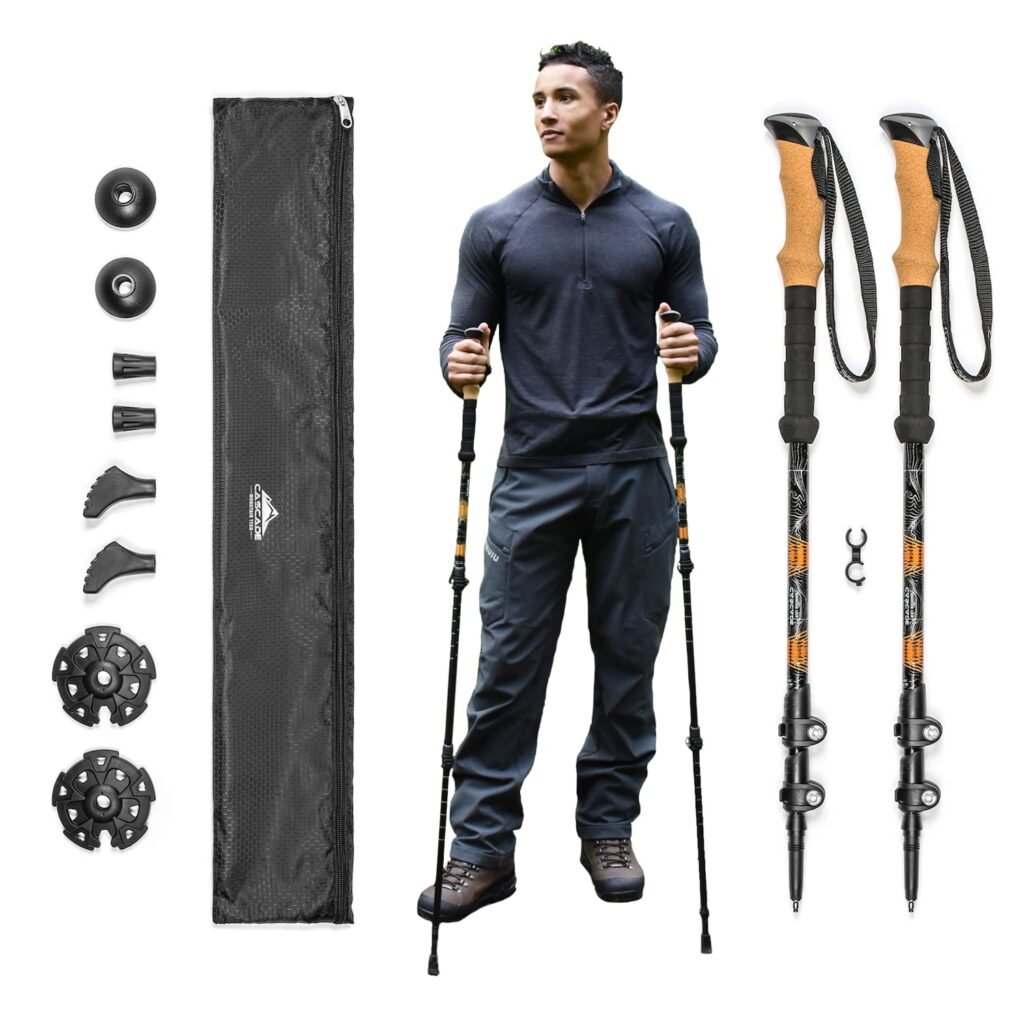Trekking poles have become essential gear for hikers and outdoor enthusiasts. These lightweight, adjustable sticks provide stability on uneven terrain, reduce strain on joints, and help maintain balance during long treks. By distributing weight and providing additional points of contact with the ground, trekking poles can significantly enhance your hiking experience.
When choosing trekking poles, several factors come into play. Weight is crucial, as lighter poles reduce fatigue during extended use. Durability is equally important, ensuring your poles withstand the rigors of various terrains and weather conditions. Adjustability allows you to customize the length for different slopes and heights, while grip comfort can prevent blisters and hand fatigue on long hikes.
Best Trekking Poles
Material composition is another key consideration. Aluminum poles offer durability and affordability, while carbon fiber options provide exceptional lightness but at a higher cost. The locking mechanism, which keeps the poles at your desired length, should be secure and easy to operate. Considering these factors will help you select trekking poles that best suit your hiking needs and preferences.
Cascade Mountain Tech Aluminum Trekking Poles

These versatile and durable trekking poles offer excellent value for hikers of all skill levels.
Pros
- Lightweight and sturdy aluminum construction
- Adjustable length with quick-lock mechanism
- Comfortable cork grips with extended EVA foam
Cons
- May not be suitable for extreme mountaineering
- Carbide tips can wear down on rocky terrain
- Plastic components could potentially break
The Cascade Mountain Tech Aluminum Trekking Poles strike an impressive balance between affordability and quality. Crafted from aircraft-grade 6061 aluminum, these poles weigh a mere 10 ounces each, making them easy to carry on long hikes without sacrificing durability.
You’ll appreciate the quick-lock mechanism that allows for easy adjustments between 26 and 54 inches. This feature comes in handy when tackling varied terrain or sharing the poles with hiking companions of different heights. The ergonomic cork grips absorb sweat and conform to your hand shape over time, while the extended EVA foam grip below offers additional placement options for steep inclines.
These poles come equipped for diverse conditions. Tungsten carbide tips provide excellent traction on most surfaces, and you’ll find interchangeable baskets for snow and mud included. A travel bag makes transportation and storage convenient. While not designed for extreme alpine use, these poles are well-suited for day hikes, backpacking trips, and even thru-hikes on major trails.
TrailBuddy Hiking Poles

TrailBuddy Hiking Poles offer a great balance of durability and portability for hikers seeking reliable support on the trail.
Pros
- Lightweight yet sturdy aluminum construction
- Easy-to-use lever lock system
- Comfortable cork grips with adjustable straps
Cons
- May not be as lightweight as carbon fiber options
- Cork grips can wear down over time
- Limited color options available
These hiking poles are crafted from aircraft-grade 7075 aluminum, providing a sturdy support system without adding excessive weight to your pack. You’ll appreciate the strength of these poles, especially when navigating challenging terrain or carrying a heavy backpack.
The lever lock system allows for quick and easy adjustments, even with one hand. This feature proves particularly useful when you need to modify pole length on the go, such as when transitioning between uphill and downhill sections of a trail.
TrailBuddy poles come equipped with cork handles that mold to your grip over time, enhancing comfort during long hikes. The moisture-wicking properties of cork help prevent slippage, giving you a secure hold even in sweaty conditions. Adjustable padded straps provide additional security and comfort.
These poles collapse down to 24.5 inches, making them convenient for travel or storage in your backpack when not in use. When fully extended, they reach up to 54 inches, accommodating a wide range of user heights. The versatility of these poles makes them suitable for various outdoor activities, from casual day hikes to more demanding backpacking trips.
TheFitLife Nordic Trekking Poles

You’ll find these trekking poles offer a solid balance of durability, adjustability, and value for your hiking adventures.
Pros
- Shock-absorbing aluminum construction
- Quick-lock system for easy length adjustment
- Comes with various accessories and carrying bag
Cons
- Rubber tips may wear out quickly on rough terrain
- Lock mechanisms might need frequent tightening
- Heavier than some premium carbon fiber options
The TheFitLife Nordic Trekking Poles are crafted from 6 series aluminum, providing a sturdy yet lightweight option for your outdoor excursions. Their shock-absorbing design helps reduce impact on your joints, making them suitable for hikers of all experience levels.
These poles feature an adjustable length ranging from 26 to 53 inches, accommodating users of various heights. The quick-lock system allows for easy adjustments on the go, though you may need to check and tighten the locks periodically during use.
The extra-long EVA foam handles offer a comfortable grip, even with sweaty hands. Included accessories like rubber tips and a carrying bag add versatility to your trekking experience. While not the lightest option available, these poles provide good value for casual hikers and beginners looking for reliable support on the trail.
Buying Guide
When selecting trekking poles, consider these key factors:
Material
Aluminum: Durable and affordable
Carbon fiber: Lightweight but more expensive
Weight
Aim for poles weighing 14-22 ounces per pair. Lighter poles reduce fatigue on long hikes.
Adjustability
Look for poles with easy-to-use locking mechanisms. Adjustable length allows for customization on varied terrain.
Grip Material
Cork: Comfortable, moisture-wicking, molds to your hand
Foam: Soft, lightweight, absorbs sweat
Rubber: Insulates in cold weather, durable
Shock Absorption
Some poles feature built-in shock absorbers. These can reduce impact on joints but add weight.
Packability
Collapsible poles are ideal for travel and storage. Check folded length if you plan to attach them to a backpack.
Tips and Baskets
Replaceable tips extend pole life. Interchangeable baskets adapt to different surfaces.
| Feature | Importance |
|---|---|
| Weight | High |
| Durability | High |
| Comfort | Medium |
| Packability | Medium |
Consider your hiking style, terrain, and budget when choosing trekking poles. Test different models to find the best fit for your needs.
Frequently Asked Questions
Choosing and using trekking poles involves considering several key factors. The right poles can enhance your hiking experience and provide important benefits.
How do I choose the right trekking poles for my height and weight?
Select poles that allow your elbows to bend at a 90-degree angle when gripping the handles. Adjust the length so your forearms are parallel to the ground. For heavier individuals, opt for sturdier poles with thicker shafts.
Consider your hiking style and terrain. Longer poles work well for downhill sections, while shorter lengths are better for uphill climbs.
What are the benefits of using trekking poles for beginners?
Trekking poles improve balance and stability on uneven terrain. They reduce strain on your knees and lower back, especially during descents. Poles help distribute your weight and engage your upper body, increasing overall hiking efficiency.
They can also be used to test water depth at stream crossings and probe for hidden obstacles on the trail.
What features should seniors look for in trekking poles?
Seniors should prioritize lightweight poles with ergonomic grips. Shock-absorbing features can reduce impact on joints. Look for easy-to-adjust locking mechanisms and wrist straps for added security.
Poles with extended grips allow for quick adjustments without stopping. Anti-shock systems can provide extra comfort on long hikes.
Are carbon fiber trekking poles better than aluminum for ultralight backpacking?
Carbon fiber poles are lighter than aluminum, making them ideal for ultralight backpacking. They absorb vibrations better, reducing fatigue on long treks. Carbon fiber is also stronger and stiffer than aluminum.
Aluminum poles are more durable and less expensive. They can bend under extreme stress without breaking, unlike carbon fiber which may shatter.
How do cork, foam, and rubber grip materials compare in trekking poles?
Cork grips mold to your hand shape over time and provide excellent comfort. They wick away moisture and remain grippy when wet. Cork is durable but can deteriorate with prolonged sun exposure.
Foam grips are lightweight and absorb sweat well. They’re comfortable in hot weather but may wear down faster than other materials.
Rubber grips offer good insulation in cold conditions. They’re durable and provide a secure hold, but can cause blisters on long hikes in hot weather.
What are the top trekking pole recommendations according to expert hikers?
Black Diamond Trail Ergo Cork poles are highly rated for their ergonomic design and durability. Leki Micro Vario Carbon poles are praised for their compact folding design and lightweight construction.
Gossamer Gear LT5 poles are favored by ultralight backpackers for their minimal weight. REI Co-op Flash Carbon poles offer excellent value with features comparable to higher-priced models.

